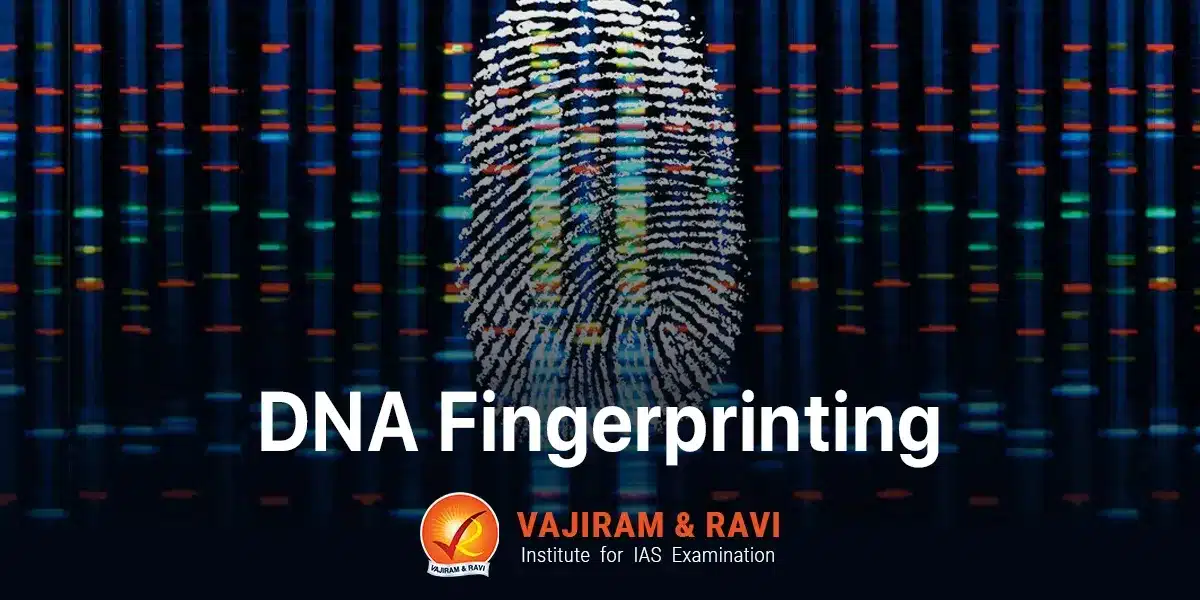DNA fingerprinting, also known as DNA profiling, is a forensic technique used to identify individuals by unique patterns in their DNA. It was developed by British geneticist Sir Alec Jeffreys in 1984. It examines repetitive DNA segments that differ between people. These Variable Number Tandem Repeats (VNTRs) act like molecular barcodes.
DNA fingerprinting has transformed forensics, enabling conclusive matches between evidence samples and reference profiles. It is now routinely applied worldwide in criminal investigations and paternity suits. The exquisite specificity of genetic profiles also makes DNA fingerprinting invaluable for wildlife research, ancestral migrations, and endangered species protection.
What is DNA Fingerprinting?
DNA Fingerprinting is a well-known method of personal identification. It is a technique to find out the variations in individuals at the DNA level.
- DNA, or deoxyribonucleic acid, is the hereditary material containing genetic instructions for the growth, development, and functioning of living organisms.
- Each individual has a unique DNA fingerprint.
Principle behind DNA Fingerprinting
DNA fingerprinting is based on the fact that the DNA contained in the nucleus of somatic cells in every individual, except identical twins, is unique.
- Although over 99% of the DNA sequences are the same across all humans, there are highly variable regions known as variable number tandem repeats (VNTRs) or short tandem repeats (STRs) that differ between individuals.
- DNA Fingerprinting analyses these VNTR or STR loci using a technique called polymerase chain reaction (PCR) to generate a genetic profile of an individual.
Process involved in DNA Fingerprinting
The key steps involved in generating a DNA fingerprint are:
- Sample collection: DNA is extracted from tissue samples like blood, bone, hair roots, semen, or buccal swab samples.
- DNA extraction: The extracted sample is purified using various chemical processes.
- PCR amplification: Using PCR, the extracted DNA is amplified with specific primers targeting the STR regions of interest.
- Separation: The amplified DNA fragments are separated based on size using gel electrophoresis.
- Detection: The separated DNA fragments of varying sizes appear as bands on the gel and are detected using fluorescent dyes.
- Profile generation: The size and number of repeats in each band are analysed to generate the distinctive DNA profile with the advanced computerised systems.
- Matching: The generated profile is then compared to other DNA profiles in a database to find any matches.
Applications of DNA Fingerprinting
DNA Fingerprinting’s unique ability to conclusively pinpoint individuals continues to transform countless facets of modern life. Its absoluteness has numerous applications, as highlighted below:
- Forensics: Comparing crime scene DNA evidence to offender/suspect profiles helps identify perpetrators.
- It is especially useful in sexual assault and homicide cases with unknown suspects. For example Shraddha Walkar murder case investigation.
- Paternity testing: Comparing a child’s DNA profile with alleged fathers can conclusively establish biological relationships for legal purposes.
- Identify the unidentified: Helps identify victims in accidents, wars, and natural disasters by matching DNA from unidentified remains to family members.
- Wildlife forensics: Used to catch poachers by analysing DNA from skins, bones, or blood samples and matching it to a particular species, geographic region, or even individual animal.
- Anthropology: Reconstruct genetic relationships and migrations of human populations over generations by studying ancient DNA samples.
- Agriculture: Determines pedigree and disease susceptibility in livestock breeding using genetic markers.
- Disease identification: Useful in the diagnosis of inherited disorders which include Huntington’s disease, sickle cell anaemia, thalassemia, cystic fibrosis, etc.
Limitations of DNA Fingerprinting
DNA fingerprinting is a powerful tool used for identifying individuals based on their unique genetic makeup. Despite being highly accurate and discriminatory, DNA fingerprinting has some limitations:
- Not 100% conclusive: The statistical probability of a match is very high but not absolute. Additional evidence may be required in criminal cases.
- Contamination: Small amounts of DNA from external sources can be unintentionally introduced at the crime scene or lab leading to errors.
- Mixed samples: It becomes challenging to separate individual profiles when the DNA sample contains a mix of multiple contributors.
- Costly equipment: Requires expensive laboratory equipment and skilled personnel, limiting applications in developing countries.
- Partial profiles: Environmental degradation of DNA samples can lead to incomplete DNA profiles making analysis difficult.
Promoting DNA Technology: India’s Initiatives
To harness the benefits of DNA Fingerprinting, the Indian government has provided several legal and institutional mechanisms to promote the use of DNA Technology including DNA Fingerprinting.
- Government institutions promoting DNA technology
- Centre for DNA Fingerprinting & Diagnostics (Hyderabad)
- Central Forensic Science Laboratory, Kolkata.
- DNA Analysis Centre at CFSL, Chandigarh.
- Centre for Cellular and Molecular Biology (Hyderabad)
- National Bureau of Plant Genetic Resource (NBPGR), New Delhi
- National Institute of Plant and Genetic Research (NIPGR), New Delhi
- DNA Technology (Use and Application) Regulation Bill, 2019: The bill regulates the use of DNA technology for establishing the identity of the people.
- The Objectives are personal identification, empowering the criminal justice delivery system, and developing institutional mechanisms.
- The bill provides for the establishment of a DNA Regulatory Board and DNA Data Banks at the national and regional levels.
- However, the centre withdrew the bill citing most of the clauses Bill covered in The Criminal Procedure (Identification) Act, 2022 and that DNA testing was now universally accepted as the “gold standard of forensic investigation”
- Among criticisms of the bill Civil society organisations and MPs had raised privacy concerns.
Last updated on April, 2025
→ UPSC Notification 2025 was released on 22nd January 2025.
→ The UPSC Vacancy 2025 were released 1129, out of which 979 were for UPSC CSE and remaining 150 are for UPSC IFoS.
→ UPSC Admit Card 2025 is expected to release in first week of May for CSE Prelims Exam 2025.
→ The UPSC Prelims 2025 is scheduled to be conducted on 25th May 2025 and UPSC Mains 2025 will be conducted on 22nd August 2025.
→ Apply once through it and aspirants can apply for various government exams conducted by UPSC.
→ The UPSC Selection Process is of 3 stages-Prelims, Mains and Interview.
→ UPSC Result 2024 is released with latest UPSC Marksheet 2024. Check Now!
→ UPSC Toppers List 2024 is released now. Shakti Dubey is UPSC AIR 1 2024 Topper.
→ Also check Best IAS Coaching in Delhi
DNA Fingerprinting FAQs
Q1. What is DNA fingerprinting?+
Q2. What is the basis of DNA fingerprinting?+
Q3. Who discovered DNA fingerprinting?+
Q4. What is the full form of VNTR and STR?+
Q5. What is PCR?What is PCR?+
Tags: dna fingerprinting quest

















